Overreliance on water from other states
California is a semi-arid region that relies heavily on irrigation for agriculture and urban areas. However, the state receives only a fraction of the precipitation that falls on other parts of the country, such as the East Coast. This means that California must rely on other sources of water, including surface water from rivers and reservoirs, as well as groundwater.
The Colorado River is one of the primary sources of water for California. The river begins in Colorado and flows through seven US states before reaching Mexico. The Colorado River Basin provides water to over 40 million people, including cities such as Los Angeles, Las Vegas, and Phoenix. However, the river is facing significant challenges due to climate change and overuse.
The Colorado River Basin is experiencing its worst drought in over a century, and the water levels in Lake Mead, the largest reservoir on the river, have dropped to historic lows. This has led to water shortages and conflicts between the seven states that rely on the river. In addition, the Colorado River is facing increasing demand from other sectors, such as energy production and recreation.
California's overreliance on water from the Colorado River is a significant challenge to the state's water supply. The state is also facing challenges with other sources of water, such as the Sacramento-San Joaquin River Delta, which provides water to over 25 million Californians. The delta is facing challenges from pollution, invasive species, and sea level rise.








